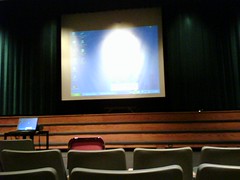Murphy's Law states: "Anything that can go wrong will go wrong." This is especially true and especially painful when there is an audience involved.
|
Gub doo gia bee? (Language Log)
[This post is chock full of all sorts of wonderful things going wrong during a series of presentations at an academic conference. This brief passage represents just a sliver of a very entertaining story]
And the other problem was that, impelled by some irresistible psychological imperative (I saw this later with several other speakers), he instinctively pointed the remote projection controller at the screen, desperately trying to get it to respond. But the computer he should have been pointing the remote at was ten or fifteen yards away on a table in a totally different direction. It was just too counterintuitive to turn 180 degrees away from the screen, so his back was toward it, in order to change the screen image. We humans are simple mammals, and we imagine that what we are focusing on is where the action is. So his clicking away with the remote was not being detected by the computer, and even if it had been detected, he would have had no idea whether anything had happened to the screen as a result.
Presentation Tip: First Impressions Matter (Professionally Speaking…)
Be prepared, with AV equipment checked, handouts sorted and slides ready. If you seem disorganized and rattled over logistics, your audience may assume that your presentation will be equally disorganized.
How to recognize someone for their service to an organization when they can’t be present in person (Conferences That Work)
- A week before the event, Nancy and I set up a test call with me calling from the laptop I would be using at the conference. It was good we did this, because it took a while to get Nancy’s camera working. We arranged for her to start Skype when she arrived at work, thirty minutes before we would start the recognition ceremony.
…
- About twenty minutes before the call, Nancy was not showing up as connected on Skype. I called her from my cell and she assured me Skype was running. I restarted Skype on my machine & this time she appeared. Phew! During the next few minutes, I muted our audio while the audience assembled.
Conference nightmares. The many faces of scientific presentations (LabLit.com) – “Prof “Defeated by technology†provides good entertainment. … I remember well giving a talk at the Hammersmith Hospital in the early days of PowerPoint when, after loading the talk onto their computer, a message came up on the screen saying your talk is being modified by the MRC system. All my demure bullet point diamonds were changed to cheeky TV screens, thereby sweeping aside any gravitas I might have had. My favourite technology nightmare, however, comes from pre-PowerPoint days, back when slides were being used in a carousel projector. One presenter could not get the carousel to work and she was told to turn the carousel over and look underneath. She did this but forgot there was no lid on the carousel. She spent the next ten minutes reassembling her talk from the random pile of slides on the floor while the audience shuffled nervously and some escaped to the bar.”
 How about two quick questions, just for the fun of it… How about two quick questions, just for the fun of it…
(okay the first one’s a little boring)
Would you rather give a presentation with your slides but not your speaker notes or have your notes but not your slides?
(the second has a little more “zing“)
You’re at the crossroads, it’s midnight, the contract has been unrolled, the pen is ready and it’s time to make the deal.
Carry a spare for EVERY piece of equipment you normally use to do a meeting and the king of the AV gremlins guarantees that you will never, ever have to use them.
In other words, would you be willing to haul around two of everything you typically bring with you knowing you will never need to use the backup because nothing will ever fail? You would propitiate the gremlins by being perfectly prepared to deal with them. Your plan B could no longer involve a quick run to the Best Buy or renting something from the hotel.
(Does that sound too much like a Twilight Zone episode?)
I think that for most people, answer to the second question would really depend on what kind of meetings they were doing and what was at stake. I wonder what offer the gremlins would make someone if they already carried two of everything.
How about you? Would you go with the slides or the notes? Would you make the deal or take your chances?
 Flying into Atlanta Tuesday brought it all back. It’s been a long, long time since I traveled anywhere other than North Jersey or Montgomery County, Maryland while on the job. In a previous professional life, I worked these these huge sales training meetings that required flying a team of ten or twenty people into places slightly more glamorous. Places people might consider giving a body part to go to. Flying into Atlanta Tuesday brought it all back. It’s been a long, long time since I traveled anywhere other than North Jersey or Montgomery County, Maryland while on the job. In a previous professional life, I worked these these huge sales training meetings that required flying a team of ten or twenty people into places slightly more glamorous. Places people might consider giving a body part to go to.
As much as I miss the venues, I miss the camaraderie more. AV and graphic techs, meeting planners, project managers, manager-managers, trainer-trainers. We were like an invading army, piling off planes and into vans, setting up camp in the on-site office and taking over the meeting rooms, unpacking box after box of supplies, subduing vast expanses of carpeted, air conditioned ballroom territory and making it serve our purposes. Putting in killer hours and putting out countless fires.
What I don’t miss are the things we needed to do back then to make sure everything went well. Things that technology has since made unnecessary.
 ©iStockphoto.com/ohdub For instance, we were still using 35mm slides. They needed to be in fragile glass mounts (plastic mounts tend to warp and jam the projector) and hand numbered with a sharpie. There was no putting a quick backup copy of your slide files on a thumb drive and tossing it into a your bag. You needed to hand-carry two complete sets of slides to the meeting, preferably using different people on different flights.
Why?
All of this was done in observance of the most important of the Ten Commandments of Doing Everything Possible to Avoid Screwing Up a Presentation: If you can’t do without it, make sure you don’t have to.
It’s sort of like this: if you need to have Pepsi, and you’re headed for Atlanta, be sure to bring your own. The hard part is knowing that you’ll need to do so.
Your Turn:
Technology might have made it unnecessary to do things like carrying two brick-like sets of 35mm slides to every meeting but unfortunately, it has made other, new precautions necessary. Which of these new, technology-driven precautions are driving you absolutely crazy. You can use the comment area to vent about it if you need to.
Despite what the title leads you to believe, this isn’t part two of last week’s “letting loose with the laser pointer” post. This week I’m going to talk about how a room’s lighting scheme can render your visuals invisible.
I don’t want to overdramatize the way it went that morning. None of the things that went wrong were that big of a deal. It’s just that I was running a little behind. Everything had been going well. Then one of the laptops failed. There’s nothing quite like getting the much dreaded blue screen of death in this situation. Okay, no problem, we had backups. Switch the bad machine out with a good one. Boots up. We’re good, just a small, unwelcome adrenaline jolt. Who needs coffee?
Not so fast. Now the remote control isn’t working. Jiggle connections, check the dip switches, reboot the laptops, change batteries. Okay, one of those things fixed it. Anyway, the speakers have been prepared to deal with a remote failure during their presentation so we’re good. Everything’s working on the back end. Now it’s time to take care of the rest. In other words, the projector and the actual image I’m projecting.
 Whoops, when did that happen? At some point, while I was busy putting out those other fires, someone came in and changed the room lighting. We had spent more than a few minutes earlier that morning making adjustments so the room would be be dark enough for the slides to show well, but also bright enough so the audience could take notes and not fall asleep after the lunch break. Unfortunately, The-One-Who-Must-Be-Obeyed (the client team’s head honcho) thought that the room was now too dark and had ordered that some be adjustments made. Problem is, one of the recessed lights that went around the parameter of the ballroom was now shining directly onto the screen, almost completely drowning out and making unreadable anything being projected. It looked a lot like the screen in the picture up there to the right. This issue is not unusual in a ballroom configured with the screen in one of the corners. Earlier, we made a point of turning all these lights off because it seemed that the chandeliers and the wall sconces would provide sufficient light. And since all of those recessed lights were on the same circuit, I couldn’t turn off one without turning off all the others. This particular ceiling was 12 feet high, there was’t a ladder handy and time was getting short. How the heck was I going to deal with this? Whoops, when did that happen? At some point, while I was busy putting out those other fires, someone came in and changed the room lighting. We had spent more than a few minutes earlier that morning making adjustments so the room would be be dark enough for the slides to show well, but also bright enough so the audience could take notes and not fall asleep after the lunch break. Unfortunately, The-One-Who-Must-Be-Obeyed (the client team’s head honcho) thought that the room was now too dark and had ordered that some be adjustments made. Problem is, one of the recessed lights that went around the parameter of the ballroom was now shining directly onto the screen, almost completely drowning out and making unreadable anything being projected. It looked a lot like the screen in the picture up there to the right. This issue is not unusual in a ballroom configured with the screen in one of the corners. Earlier, we made a point of turning all these lights off because it seemed that the chandeliers and the wall sconces would provide sufficient light. And since all of those recessed lights were on the same circuit, I couldn’t turn off one without turning off all the others. This particular ceiling was 12 feet high, there was’t a ladder handy and time was getting short. How the heck was I going to deal with this?
I know what you’re thinking, just break out the BB gun. One quick, quiet “plink”, a little discreet sweeping up. Done.
Unfortunately, that’s one of the few pieces of gear I don’t haul to meetings with me. However, having been in this situation before, I knew of a better solution that would be almost as quick and wouldn’t make the hotel staff nearly so angry. It’s a light bulb changing pole and every hotel with high ceilings should have one.
The call went out to the maintanence department. A few minutes later the offending bulb was removed and we were good to go. Like I said, none of this was particularly earthshaking or heroic. It was just a little more stressful than it needed to be because we were so close to show time.
Now that you’ve seen the light, here are a few things to keep in mind:
- If you get to participate in a pre-meeting site visit (always a good idea), try to get a sense of what the room’s lighting issues might be and begin thinking about how you might deal with them.
- Once you’re on site for the actual meeting, take a few minute to have the staff show you how the room’s lighting controls work. Knowing what the system can and can’t do will often save you a lot of grief. Just as important, you won’t need to waste time searching for the appropriate staff member to make adjustments when time is short.
- Consider getting your hands on your own light bulb changing pole. They are cheap, light and easy to transport. The hotel maintenance staff might not alway be as available for you as they were for me that morning.
- Finally, don’t consider any part of your setup finalized until you’re sure The-One-Who-Must-Be-Obeyed isn’t going to weigh in with some adjustments.
Remember, of all the things you need to control in order to have a successful presentation, light is one of the most important. Especially if the presentation depends on the visuals as much as on what’s being said.
Related Resources:
- Control of Ambient Light: “Controlling ambient light is crucial for maximizing the contrast in the video image. Video has a limited contrast range compared to film, and suffers much worse in the presence of ambient light on the screen.” This page has a good mock up of how ambient light can affect slide readability.
- We usually don’t have much say in what type of screen we will be required to project on. However, picking the appropriate screen for the conditions in a particular meeting space is an art as well as a science. This Wikipedia page will give you a good sense of the many factors involved in this decision.
|
 How about two quick questions, just for the fun of it…
How about two quick questions, just for the fun of it… Flying into Atlanta Tuesday brought it all back. It’s been a long, long time since I traveled anywhere other than North Jersey or Montgomery County, Maryland while on the job. In a previous professional life, I worked these these huge sales training meetings that required flying a team of ten or twenty people into places slightly more glamorous. Places people might consider giving a body part to go to.
Flying into Atlanta Tuesday brought it all back. It’s been a long, long time since I traveled anywhere other than North Jersey or Montgomery County, Maryland while on the job. In a previous professional life, I worked these these huge sales training meetings that required flying a team of ten or twenty people into places slightly more glamorous. Places people might consider giving a body part to go to.
